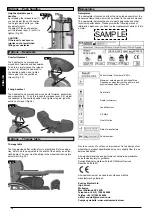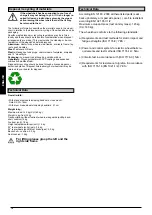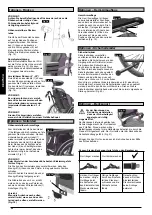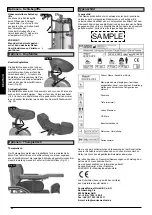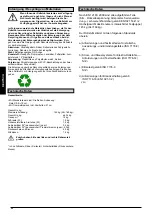
15
Safety Inspection and Maintenance
As the user, you will be the first to notice any possible operational
defects. Therefore we recommend to check the following before
every use:
- Correct tyre pressure
-´Correct wheel lock function
- All removable parts are secure (e.g. arm rest, hanger, uick release
axles…)
- No visible damages e.g. of frame, back, seat and back sling,
wheels, hangers, footplates…)
In case of any damage/ malfunction please contact your authorized
dealer
Tyres and mounting
Tyres and mounting
Solid tyres are standard.
With pneumatic tyres make sure that you maintain the correct tyre
pressure, as this can have an effect on wheelchair performance. If
the tyre pressure is too low, rolling resistance will increase, requiring
more effort to move the chair forward. Low tyre pressure also has a
negative impact on manoeuvrability. If the tyre pressure is too high,
the tyre could burst. The correct pressure (min 3,5 bar) for a given
tyre is printed on the surface of the tyre itself.
Tyres can be mounted the same way as an ordinary bicycle tyre.
Before installing a new inner tube, you should always make sure
that the base of the rim and the interior of the tyre are free of foreign
objects. Check the pressure after mouting or repairing a tyre. It is
critical to your safety and to the wheelchair’s performance that
regulation air pressure be maintained and that tyres be in good
condition.
Maintenance and care
Maintenance
• Check the tyre pressure every 4 weeks. Check all tyres for wear
and damage.
• Check the brakes approximately every 4 weeks to make sure that
they are working properly and are easy to use.
• Change tyres as you would an ordinary bicycle tyre.
• All of the joints that are critical to using your wheelchair safely are
self-locking nuts. Please check every three months to make sure
that all bolts are secure (see the section on torque). Safety nuts
should only be used once and should be replaced after use.
Note:
Wherever torque settings are specified it is strongly recommended
that a torque meter is used to verify the correct torque is achieved.
• Please use only mild household cleansers when your wheelchair
is dirty. Use only soap and water when cleaning the seat upholster
and lap belt.
• If your wheelchair should ever get wet, please dry it after use.
• A small amount of sewing-machine oil should be applied to quick
release axles approximately every 8 weeks.
Depending on the frequency and type of use, we recommend taking
your wheelchair to your authorised dealer every 6 months to have it
inspected by trained personnel.
CAUTION:
Sand, salt and exposure to sea water can damage the
bearings of front/ rear wheels. Clean and dry the wheelchair
thoroughly after exposure.
The following parts can be removed and sent to the manufacturer /
dealer for repair:
• Rear wheels
• Armrest
• Hanger
• Anti - tips
These components are available as spares. More details can be
found in the parts manual.
Hygiene when being reused:
When the chair is to be reused, it should be prepared carefully, and
wiped and treated with spray disinfectant on all surfaces which could
come into contact with the user.
In doing this, you must use a liquid for alcoholic quick disinfection for
medical products and medical inventory when you require a quick
effect.
Please pay attention to the manufacturer`s instructions of the disin
-
fectant you are using.
In general, a safe disinfectant cannot be guaranteed on seams. We
therefore recommend, that you properly dispose of seat and back
slings in the case of microbacterial contamination with active agents
according to § 6 infection protection law.
Storage
The wheelchair should always stored in dry conditions
Trouble shooting
Wheelchair pulls to one side
• Check tyre pressure (pneumatic tyres only)
• Check to make sure wheel turns easily (bearings, axle)
• Check the castor angles are set consistently and make proper
contact with the ground
• Ensure castor fork bearings rotate freely
Castors begin to wobble
• Check the castor angle
• Check to make sure all bolts are secure; tighten if necessary (see
the section on torque)
• Check to make sure both castors are making proper contact with
the ground
Wheelchair squeaks and rattles
• Check to make sure all bolts are secure; tighten if necessary (see
the section on torque)
• Apply small amount of lubrication to spots where movable
parts
come in contact with one another
Wheelchair begins to wobble
• Check angle at which castors are set
• Check tyre pressure
• Check to see if rear wheels are adjusted differentl
Dampeners and cables
Caution: In order to avoid any reduc-
tion in function, you
must make sure that the cables are
never set too taut.
Problem: Play in the lever
Solution: Loosen the adjustment screw
(1) until the lever (2)
has no play.
Seat angle setting
Problem:
The seat moves out of position, without the use of the dampener
release
Cause:
The Bowden cables on the buffer are stretched too tightly.
Solution:
Set the Bowden cables on the adjustment screw(1)
Caution:
Protect the Bowden cable from damage (buckling).
Should it be buckled, then it must be replaced.
Seat depth setting:
Problem:
The seat will not move in or out (on one side or both sides).
Cause:
The clamping mechanism is slightly catching
Solution:
Dislodge by gently tapping each side of the seat frame.
2
1
ENGLISH
Summary of Contents for Breezy Relax2
Page 131: ...131 ...














